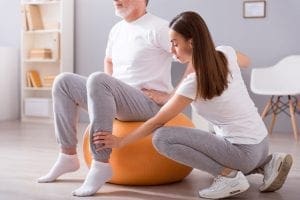June 6, 2019 / Blog / ilcorp
Stroke Awareness – Prevention and Recovery Tips

Did you know that stroke is a leading cause of disability and death in the United States? While over 800,000 people in the US experience a stroke each year, the good news is that over 80% of strokes can be prevented by making healthy changes to your diet and lifestyle. Learn some tips for stroke prevention and discover the options available for recovering from a stroke.
The Best Ways to Prevent a Stroke
The best time to start making a prevention plan against stroke is right now. Consult your healthcare provider about risk factors involving stroke and start making a plan that you and your loved ones can easily follow. With the right preparation, 80% of strokes can be prevented. There are plenty of ways to incorporate stroke prevention into your daily life, such as:
- Manage your blood pressure. High blood pressure is the leading risk factor of stroke. Try exercising regularly, eating a healthy diet and managing your stress to keep your blood pressure normal.
- Stop smoking, and if you don’t smoke, don’t start. Smoking decreases the oxygen in your body, making it a controlled risk factor for stroke.
- Limit your alcohol intake. According to the Center for Disease Control and Prevention, drinking can increase your blood pressure. As a general guideline, women should have no more than one drink per day, while men are advised to consume no more than two.
- Diabetes is a risk factor for stroke. Talk to your doctor about your blood sugar and follow any recommended tips to keep your levels under control.
- Stay physically active. Exercise helps maintain healthy cholesterol and blood pressure which can reduce your stroke risk.
What Stroke Recovery and Treatment Options are Available?
There are several restorative treatments available for individuals who have experienced a stroke. Because no two people experience stroke in the same manner, recovery options will vary based on the severity and location of the condition.
Physical Therapy
Motor-skill exercises help improve muscle strength and coordination. Mobility training addresses stability and balance, using mobility aids such as chairs or canes to strengthen ankles and legs. Other types of physical therapy involve increased focus on affected limbs while the unaffected limb is kept in place. Technology can be a helpful tool in physical therapy, such as using robotics to help with repetitive motions, or activity monitors to increase post-stroke activity.
Cognitive and Mental Health Therapy
Occupational therapy can help with abilities that have been lost, such as memory, problem-solving, social skills and safety awareness. Speech therapy can help with regaining the ability to speak, listen and write. While physical wellness is often top of mind during stroke recovery treatment, emotional impact is important to address as well. Emotional therapy includes stroke support groups for survivors and their families. In some cases, further counseling may be helpful in case stroke causes personality changes or other concerns.
Resort-style Rehabilitation Services at Immanuel Living
Immanuel Living offers short-term rehabilitation services at our vibrant senior living community in Kalispell, MT. You’ll find private suites with flat-screen TVs and European showers, a well-equipped fitness center and concierge service at The Retreat, our comfortable short-term rehabilitation and post-acute care center. Contact us today to discover and learn more about our restorative care offered in a compassionate setting.



 Is 75 The New 65? How The Definition Of Aging Is Changing
Is 75 The New 65? How The Definition Of Aging Is Changing